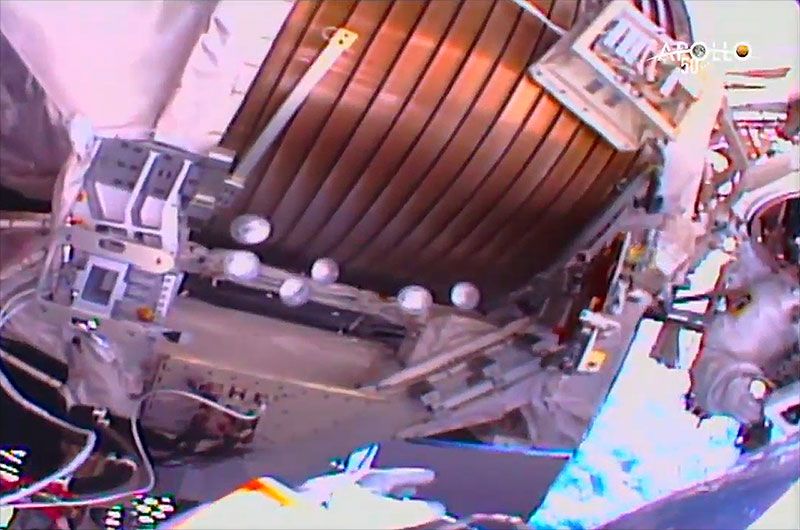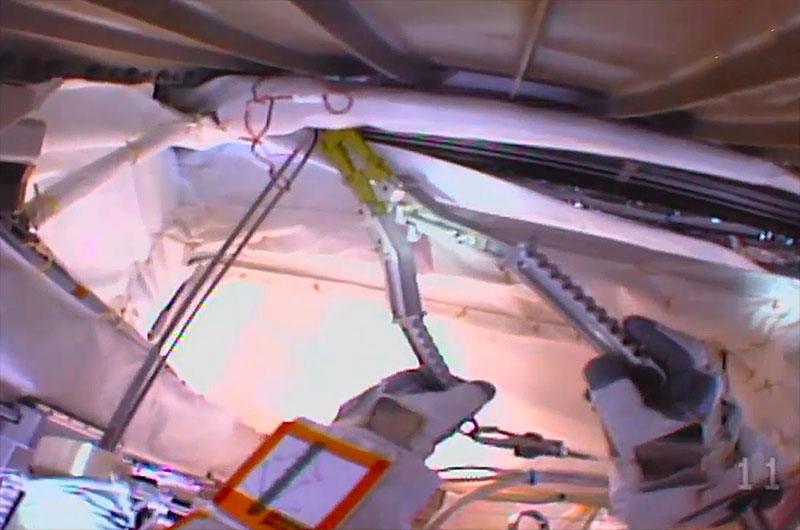Astronauts Perform Spacewalk Surgery to Repair Cosmic Ray Detector
Two astronauts have completed "surgery" outside of the International Space Station, slicing small metal tubes as part of the efforts to repair a state-of-the-art cosmic ray detector.
Expedition 61 crewmates Luca Parmitano of the European Space Agency (ESA) and Drew Morgan with NASA ventured outside of the space station on Friday (Nov. 22) for a 6 hour and 33 minute extravehicular activity (EVA, or spacewalk). The excursion continued the work they began one week ago to replace the failing cooling system for the $2 billion Alpha Magnetic Spectrometer (AMS).
The science instrument, which was installed on the space station in 2011, needs new coolant pumps so it can continue capturing high-energy cosmic rays in order to reveal the nature of antimatter, "dark matter" and "dark energy."
Video: Watch the Astronauts Begin the 4-Spacewalk Repair

During their first spacewalk on Nov. 15, Parmitano and Morgan removed and jettisoned a debris shield cover and carbon fiber composite insulation cover from the AMS, exposing the lines to the degraded cooling system, and prepared their work area by installing temporary handrails and maneuvering aids. The AMS was not designed to be worked on in space and is positioned high atop the station's backbone truss.
Friday's spacewalk, which began at 7:02 a.m. EST (1202 GMT), had the two astronauts pick up where they left off, connecting new power and data cables that will lead to the upgraded coolant pump module to be installed on the next EVA. As they had last week, Parmitano worked from at a foot restraint attached to the end of the Canadarm2 robotic arm, while Morgan free floated near him.
"And I have a good mate," reported Parmitano, as he secured the second of two power cable connectors about an hour and 40 minutes into the EVA.
"Nicely done," replied Morgan.
Get the Space.com Newsletter
Breaking space news, the latest updates on rocket launches, skywatching events and more!
"You made that look easy today, Luca. That was way different than I was expecting to see. Nice work there," radioed Canadian astronaut Jeremy Hansen, who as capcom, or spacecraft communicator, guided the spacewalkers through their work from Mission Control in Houston.
Related: Astronauts Face Most Challenging Spacewalks Ever for ISS Repair
Parmitano and Morgan next installed a mechanical attachment device to which the upgraded thermal tracker pump system will be mounted on the third spacewalk.
NASA astronaut Jessica Meir, working at a robotics control station inside the station's U.S. Destiny laboratory, then repositioned Parmitano on the Canadarm2 to begin the next task, cutting a 0.2-inch-wide (6 millimeter) line to vent the carbon dioxide that fed into the AMS's failing pumps. This cut permanently disabled the instrument's original cooling system, which began having problems in 2014.
Parmitano's first snip with the "rough cutter" — one of 20 specially-designed tools for this series of AMS spacewalks — was confirmed by Mission Control to begin depressurizing the line. The rate of venting, though, was slower than expected and so Parmitano was directed to cut another line, resulting in a brief visible release of carbon dioxide into space.
More: How the Alpha Magnetic Spectrometer Works (Infographic)

Once the purging of the fill line was complete, Parmitano turned to a different series of eight stainless steel tubes, which will be used to splice in the new pumps. After cutting each, he installed a labeled cap on the end of the tube to protect from the sharp edge he created and to help with identifying the tubes as the new lines are connected.
"Luca, pop quiz, I've got a warning here. What's the rule of thumb for the rough cutters?" asked Hansen.
"My fingers?" replied Parmitano as he prepared to cut more of the coolant lines.
"Exactly, you pass," said Hansen, as laughter was heard in Mission Control.

Six of the lines were cut at the worksite from the first spacewalk, where the debris shield was removed. Another two were then severed from the opposite side of the AMS, wrapping up the work for this second of at least four planned spacewalks.
On the next EVA, currently scheduled for Dec. 2, Parmitano and Morgan will use another tool to smooth the end of the cut coolant lines in preparation for their being swaged, or spliced, with the lines leading to the new coolant pump module.
Friday's spacewalk, which ended at 1:35 p.m. EST (1835 GMT), was the 223rd EVA in support of space station assembly and maintenance since 1998 and the tenth this year. It was the fourth career spacewalk for Parmitano and the fifth for Morgan.
- How the Antimatter-Hunting Alpha Magnetic Spectrometer Works (Infographic)
- In Pictures: The Most Memorable Spacewalks in History
- Antimatter-Hunting AMS Experiment in Space (Photos)
Follow collectSPACE.com on Facebook and on Twitter at @collectSPACE. Copyright 2019 collectSPACE.com. All rights reserved.

Join our Space Forums to keep talking space on the latest missions, night sky and more! And if you have a news tip, correction or comment, let us know at: community@space.com.

Robert Pearlman is a space historian, journalist and the founder and editor of collectSPACE.com, a daily news publication and community devoted to space history with a particular focus on how and where space exploration intersects with pop culture. Pearlman is also a contributing writer for Space.com and co-author of "Space Stations: The Art, Science, and Reality of Working in Space” published by Smithsonian Books in 2018.In 2009, he was inducted into the U.S. Space Camp Hall of Fame in Huntsville, Alabama. In 2021, he was honored by the American Astronautical Society with the Ordway Award for Sustained Excellence in Spaceflight History. In 2023, the National Space Club Florida Committee recognized Pearlman with the Kolcum News and Communications Award for excellence in telling the space story along the Space Coast and throughout the world.










